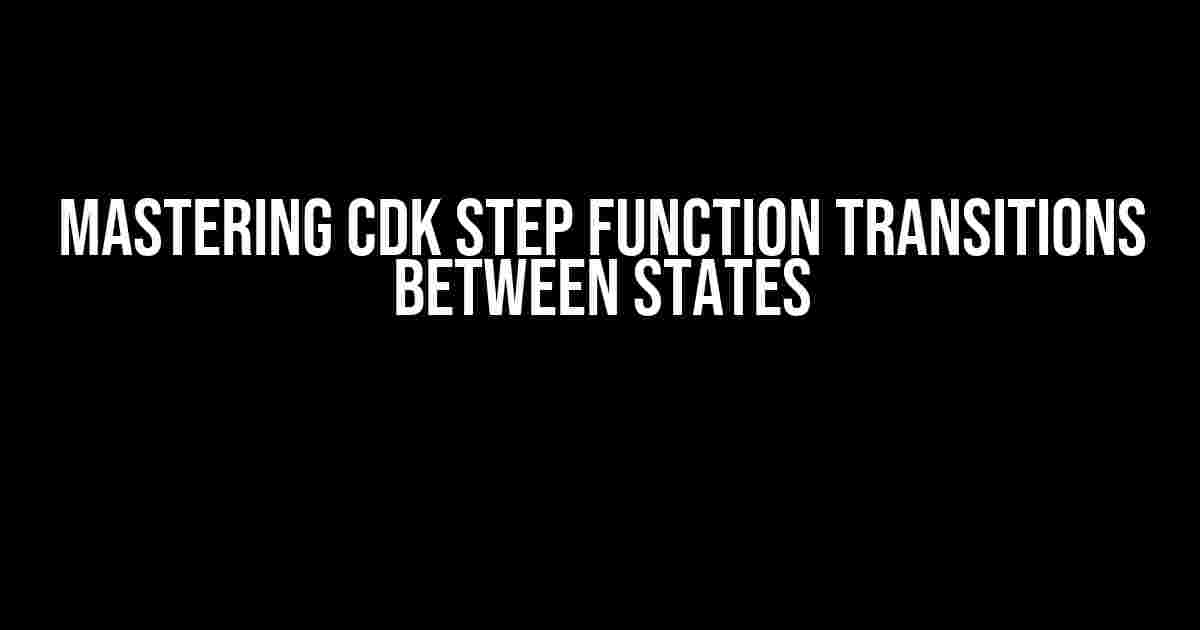Cloud Development Kit (CDK) Step Functions allow developers to coordinate the components of distributed applications and microservices into a workflow. One of the essential features of CDK Step Functions is the ability to transition between states. In this article, we’ll delve into the world of CDK Step Function transitions between states, exploring the benefits, types of transitions, and best practices for implementation.
Benefits of CDK Step Function Transitions Between States
CDK Step Function transitions between states offer several benefits, including:
- Improved workflow orchestration: Transitions enable the coordination of complex workflows, ensuring that each step is executed in the correct order.
- Error handling and recovery: By defining transitions, you can handle errors and exceptions more effectively, reducing the risk of workflow failures.
- Visibility and tracking: Transitions provide a clear audit trail, making it easier to track the progress of your workflow and identify areas for optimization.
Types of CDK Step Function Transitions
CDK Step Functions support several types of transitions, including:
- Next: Transitions to the next state in the workflow.
- Choice: Transitions to a specific state based on a condition or predicate.
- Succeed: Transitions to a terminal state, indicating the successful completion of the workflow.
- Fail: Transitions to a terminal state, indicating the failure of the workflow.
- Parallel: Transitions to multiple states concurrently, enabling parallel processing.
Implementing CDK Step Function Transitions
To implement CDK Step Function transitions, follow these best practices:
- Define clear and concise state names: Use descriptive state names to ensure easy understanding of the workflow.
- Use meaningful transition names: Use descriptive transition names to clarify the flow of the workflow.
- Implement error handling: Define error handling mechanisms to handle unexpected errors and exceptions.
- Test and validate your workflow: Thoroughly test and validate your workflow to ensure correct transition behavior.
Conclusion
In conclusion, CDK Step Function transitions between states are a powerful feature that enables the creation of complex, scalable, and fault-tolerant workflows. By understanding the benefits, types, and best practices of transitions, you can unlock the full potential of CDK Step Functions and take your application workflow to the next level.
Here are 5 Questions and Answers about “CDK Step function transition between state” in a creative voice and tone:
Frequently Asked Question
Get answers to your burning questions about CDK Step functions and state transitions!
What triggers a state transition in a CDK Step function?
A state transition in a CDK Step function is triggered by a task’s execution result, which can be either a success or a failure. This result is then evaluated against the transition rules defined in the state machine, determining the next state to transition to.
Can I define multiple next states for a single task in CDK Step function?
Yes, you can! CDK Step functions allow you to define multiple next states for a single task based on different conditions. This is achieved by adding multiple `Next` states to a task, each with its own conditional expression.
How do I handle errors and exceptions during state transitions in CDK Step functions?
You can handle errors and exceptions during state transitions by defining a `Catch` block in your state machine. This block allows you to specify a state to transition to when an error occurs, enabling you to handle and recover from unexpected issues.
Can CDK Step functions support parallel state transitions?
Yes, CDK Step functions do support parallel state transitions! You can use the `Parallel` state to execute multiple tasks concurrently, allowing your state machine to transition to multiple next states simultaneously.
Is it possible to visualize the state transitions in a CDK Step function?
Absolutely! CDK Step functions provide a visual representation of your state machine, making it easy to understand and debug the state transitions. You can use tools like the AWS Step Functions console or third-party visualizers to visualize your state machine.
